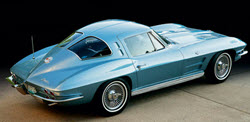1970 Corvette Sting Ray

The 1970 Corvette Sting Ray belongs to the third generation Corvettes, the C3’s. The first car of this generation, the 1968 model, received quite a lot of criticism and Chevrolet worked hard not to make the same mistakes over again. The 1969 and 1970 Corvette Sting Ray are therefore highly regarded cars among Corvette enthusiast.
The 1969 Corvette Sting Ray was slightly more comfortable than its predecessor, but with the 1970 Corvette Sting Ray, the manufacturers took comfort and cosiness to the next level and introduced especially comfortable seats. The seat belt retractor was of a better quality and the headlight washers more reliable. Headrests had been included in the all Corvettes since 1969. An interesting new option for the 1970 Corvette Sting Ray was California Emissions. This feature cost $37 and was included in slightly more than 10 percent of the cars.
When the headlights of the 1970 Corvette Sting Ray were kept in the down position, they blocked a major part of the cool air flow for the hot radiator. Air to cool down the radiator was therefore pulled from under the car. Another notable change in the 1970 Corvette Sting Ray was how the squared off amber turn signal indicator was surrounded by a so called “ice cube” grill. The 1970 model also had fender louvers.
A total of 17,316 1970 Corvette Sting Ray cars were produced, most of them coupes. In 1965, over 65 percent of the Corvettes were convertibles. Five years later, the numbers had changed and of the 17,316 1970 Corvette Sting Ray cars, over 10, 000 were coupes (62 %). Coupes were however still more expensive than cabriolets. In 1970, a base Corvette Coupe with 350 cu. in. 300 hp engine and wide ratio four speed manual transmission cost $5,192. This can be compared to the convertible, where the price tag showed a mere $4,849.
One of the most interesting new 1970’s features was the introduction of the LT-1 engine. For an additional $448, the standard engine would be replaced by a LT1 350 cu. in. engine capable of 370hp. The LT-1 engine has been described as a solid lifter version of the small block and it received a lot of praise from both die-hard Corvette aficionados and general car enthusiast. Road racers appreciated the new motor since it could provide a lot of horsepower despite being light weight. This was a much sought after feature, since it meant that you could go really fast without loosing control over the balance.
The LS5 was now the only option for those who wanted a 454 cu. in. big block motor: It cost $290 and was capable of 390hp. For nor more than $158, you could get a 350 cu. in. engine capable of 350hp instead of the standard 300 hp. This was a popular alternative and the 350 cu. in. 350hp engine was installed in over ¼ of all cars. The 1970 Corvette Sting Ray has a special place in many peoples heart since it was the last Corvette with a high compression engine. In the future, unleaded gasoline would become standard fuel and high octane gasoline difficult to obtain.



